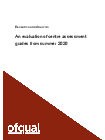Research: Evaluation of centre assessment grades and grading gaps in summer 2020

2 research reports looking at the awarding of centre assessment grades for GCSEs, AS and A levels in summer 2020.
Documents
An evaluation of centre assessment grades from summer 2020
Ref: Ofqual/21/6816/1PDF, 4.19MB, 85 pages
This file may not be suitable for users of assistive technology.
Request an accessible format.
If you use assistive technology (such as a screen reader) and need aversion of this document in a more accessible format, please email [email protected].Please tell us what format you need. It will help us if you say what assistive technology you use.
An evaluation of centre assessment grades from summer 2020
Ref: Ofqual/21/6816/1HTML
Grading gaps in summer 2020: who was affected by differences between centre assessment grades and calculated grades?
Ref: Ofqual/21/6816/2PDF, 925KB, 41 pages
This file may not be suitable for users of assistive technology.
Request an accessible format.
If you use assistive technology (such as a screen reader) and need aversion of this document in a more accessible format, please email [email protected].Please tell us what format you need. It will help us if you say what assistive technology you use.
Grading gaps in summer 2020: who was affected by differences between centre assessment grades and calculated grades?
Ref: Ofqual/21/6816/2HTML
Details
2 reports looking at the awarding of centre assessment grades in England for summer 2020 GCSE, AS and A level qualifications. The reports investigate the relationship between factors influencing teacher grading judgements and the grades awarded under normal exam circumstances, and whether candidates with specific characteristics were more likely to be affected by discrepancies in grades between their centre assessment grades (CAGs) and calculated grades.
An evaluation of centre assessment grades from summer 2020
Centre assessment grades in 2020 were, on average, around half a grade higher than grades from previous years for both GCSE and A levels. However, reassuringly, analysis indicated that the majority of relationships between grades and other features studied had not substantially changed compared to previous years, once normal variation between years had been accounted for. This suggests that although teacher grades were moderately higher than previous years’ grades, they did not introduce any substantial bias or different patterns of grading.
The strongest predictor by far of grade outcomes was a candidate’s prior attainment for both GCSE and A level. This relationship was slightly stronger in 2020 compared to previous years. This increase in predictive power of prior attainment may represent CAGs factoring out ‘unpredictable’ variation in student outcomes, seen in normal years due to factors such as exam anxiety, last minute revision or the combination of questions which come up on exam papers. Alternatively, it may represent teachers’ over-reliance on prior attainment as a source of data and not sufficiently taking into account individual candidate differences in performance.
Overall, we conclude that although there are some minor differences in the relationships between the candidate and centre level features analysed and grades in 2020, the patterns of grading are remarkably similar to previous years, particularly for GCSE.
Grading gaps in summer 2020: who was affected by differences between centre assessment grades and calculated grades?
This paper presents findings from our research into 2020 assessment outcomes, and examines what factors are associated with the likelihood of candidates receiving calculated grades that were different from their CAGs and, in particular, with calculated grades three grades or more lower than their CAGs across their A level qualifications (three-grade gap).
The results show that, taking centres and subject choices into account, there is no evidence that candidates’ socio-economic background, SEND status or the language spoken at home were associated with the likelihood of receiving a three-grade gap. There was some evidence that females and Asian and British Asian students were more likely to receive a three-grade gap than males and white students respectively, but the effect sizes were very small. More precisely, the model predicts that a white female candidate, attending the median school or college, would have a 15.7% likelihood of experiencing a three-grade gap. If that candidate were male the probability of a three-grade gap would be 14.5%. The corresponding probabilities for female and male Asian candidates would be 17% and 15.6%.
It is therefore possible to conclude that in summer 2020 the likelihood of experiencing a three-grade gap between CAGs and calculated grades was not systematically and substantially higher for specific groups of students.
Published 29 July 2021













Responses